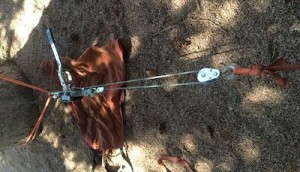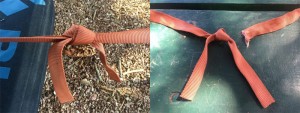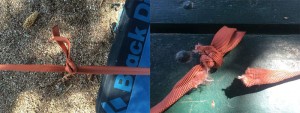There are some rare exceptions, but the general rule is — NO!
Knots and bends should be loaded along their major axis. So there are times when it is best to use an overhand knot and other times when it is best to use an overhand bend (aka ring bend or water knot). Tying a flat overhand, often called an EDK (for European Death Knot) does not load on the axis. Instead, the knot is pulled apart under load.
 To illustrate the problems, we performed some quick-look testing using a cable come-along for pulling power and measured the forces with a Rock Exotica Enforcer load cell. The difference between the overhand bend and the flat overhand were striking. Our hypothesis at the start of the testing was that the flat overhand would prove to be weaker, but could just as likely fail due to knot rolling off the end of the tails before the webbing actually broke.
To illustrate the problems, we performed some quick-look testing using a cable come-along for pulling power and measured the forces with a Rock Exotica Enforcer load cell. The difference between the overhand bend and the flat overhand were striking. Our hypothesis at the start of the testing was that the flat overhand would prove to be weaker, but could just as likely fail due to knot rolling off the end of the tails before the webbing actually broke.
We conducted one test of each knot/bend using new one inch tubular mil spec webbing, rated 4,000 lbs. Here are the results:
Overhand Bend (aka Ring Bend, Water Knot)
1558 lbf – slight knot/tail slippage
2043 lbf – failure
Overhand bend before and after failure. Tails started at 4.5 inches. One tail remained 4.5 inches. The other measured 4.25 inches after failure.
Flat Overhand (aka EDK)
1178 lbf – observable damage in webbing at knot
1306 lbf – knot began to slip, force dropped to 905 lbf
1368 lbf – failure
Flat overhand knot before and after failure. Tails started at 4.5 inches. Knot rolled, reducing tails to 2 inches.
Conclusion
Much better to use a knot or bend that loads along the major axis. Loading that pulls the knot apart results in the potential for two different failure mechanisms; (1) material failure (at a significantly lower breaking point) and (2) the knot rolling off the ends of the tails.
But what about those exceptions?
One example might be … A wrap three pull two around a smooth, round, large-diameter object, like a tree. If a flat overhand is used to connect the ends of the webbing … and the knot is placed on the side of the tree facing the load so there is 360 degrees of webbing wrapped around the tree … friction from the wraps will hold a significant portion of the load. That would put significantly less force on the knot. In fact, the tension on the knot would be negligible.

